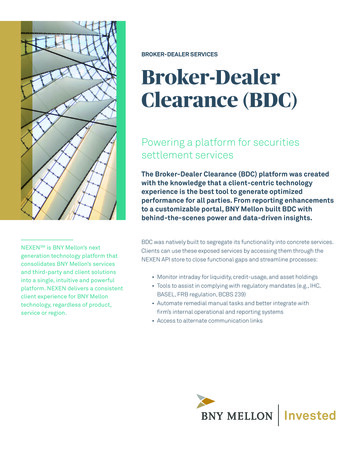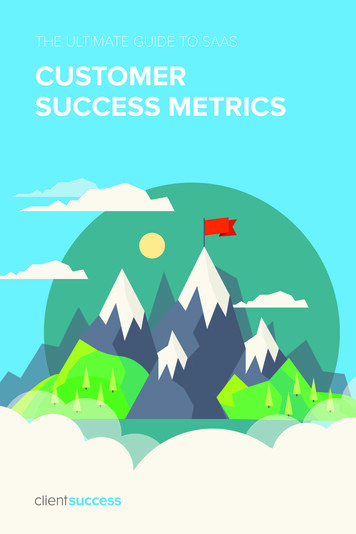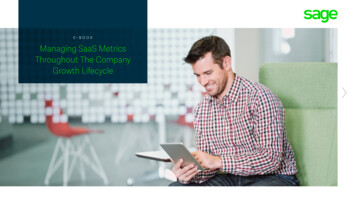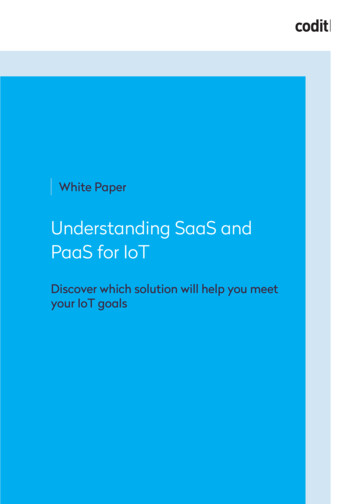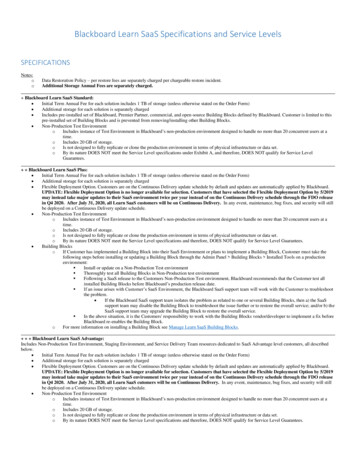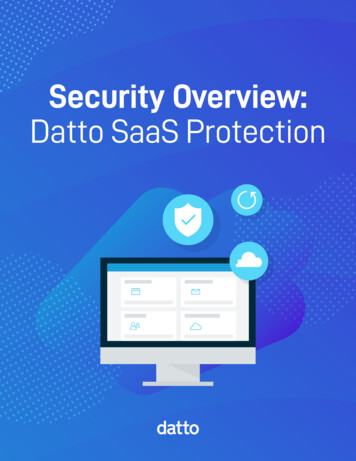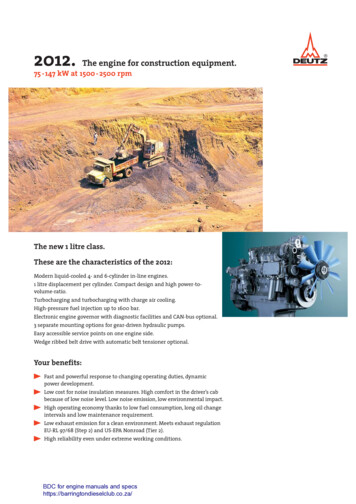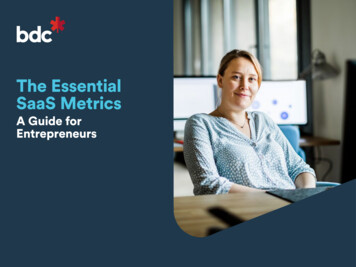
Transcription
The EssentialSaaS MetricsA Guide forEntrepreneurs
Summary123How SaaScompaniesare differentUsing metricsto optimize yourSaaS businessFindthe financingyou needInstead of one-time purchases SaaScustomers pay every month (or year) toaccess software or services via the Internet.Ideally, this business model generatesa steady and growing stream of revenue,but it can also present challenges that canthreaten the survival of a SaaS company.It’s critical for SaaS companies to closelytrack key metrics as the business grows. Dataon customer acquisition, lifetime value andchurn rates, among other measures, will guidestrategic decisions about what improvementsneed to be made to the business.The characteristics of SaaS businessescan make it difficult for entrepreneurs to getthe capital they need. Learning what lendersand other financiers are looking for in aSaaS business will improve your chances ofgetting financing and growing your company.bdc.caThe Essential SaaS Metrics – A Guide for Entrepreneurs
1How SaaS companies are differentWhat is a SaaScompany?A software as a servicecompany:3 differences of the SaaSbusiness model develops an application and makes it available1to customers over the Internet charges customers a subscription fee to usethe application manages and updates the software to meet userneeds and security requirementsRecurring revenue Instead of a one-time purchase, SaaS customers pay overa period of time—a monthly or annual fee to use an application.The goal for a SaaS business is to create a growing streamof recurring revenue by attracting new customers andlimiting cancellations.2Scalability Because it’s digital and delivered over the Internet, a SaaSproduct can be sold to an unlimited number of users with onlysmall increments to cost of goods sold. For SaaS businesses,key expenses are for R&D, and sales and marketing to acquireand keep customers.3Comparable metrics SaaS businesses have similar characteristics and generate thesame types of data. This makes them highly comparable, allowingentrepreneurs, lenders and investors to quickly understand abusiness and benchmark its performance against others.bdc.caThe Essential SaaS Metrics – A Guide for Entrepreneurs
1How SaaS companies are differentWhy SaaS companies typically losemoney in the early stage1In the early stages, SaaS companies lose moneybecause they must spend on R&D, and sales and marketing.The business then makes the money back as customerspay subscription fees over subsequent months (or years).The company generates negative cash flow until it turnsthe corner and becomes profitable.The period of unprofitability typically lasts 12 to 36months. This can be challenging for entrepreneurs andinvestors because money must be invested to bringon new customers with the faith that these investmentswill pay off down the road.Single customer cumulative cash flow 3,000 2,000 1,000 0– 1,000– 2,000– 3,000– 4,000– 5,000Negative cash flow– 6,000– 7,000123456789 10 11 12 13 14 15 16 17 18# of months since client acquisition1. S ource for figures on pages 4, 5 and 11: For Entreprepreneurs from David Skok“SaaS Metrics 2. 0— A Guide to Measuring and Improving What Matters.” Accessed June 29, -2/bdc.caThe Essential SaaS Metrics – A Guide for Entrepreneurs
1How SaaS companies are differentHigher growth higher lossesin the early daysImpact of faster growth on profit and loss/cash flow 25,000The more a SaaS business spends to grow itscustomer base in the early days, the deeper itslosses will be. However, if the business is successfulin finding and retaining customers, it will eventuallybe rewarded with a higher rate of growth. 20,000 15,000 10,000 5,000 0– 5,000– 10,0001591317212529333741495357# of months in businessGrowth rate: 2 more customers per monthGrowth rate: 5 more customers per monthGrowth rate: 10 more customers per monthbdc.caThe Essential SaaS Metrics – A Guide for Entrepreneurs
2Using metrics to optimize your SaaS business4 metricsto make senseof it allMetrics allow entrepreneurs, investors and lendersto see how a company is progressing over time.For SaaS businesses, key performance metricsindicate whether a company is meeting its growthtargets and where improvements are needed.bdc.caThe Essential SaaS Metrics – A Guide for Entrepreneurs
2Using metrics to optimize your SaaS business1Monthly recuring revenueRecurring revenue Recurring revenue is a fundamental measure of how a SaaSbusiness is doing in terms of attracting and retaining customers ina given period—monthly (MRR), quarterly (QRR) or annually (ARR).Tracking recurring revenue allows you to understand how fast thebusiness is growing as well as how much cash is coming in.Recurringrevenue Subscription revenue owedduring a time periodAmount of elapsed time 2,000 1,500 1,000 500 0- 500- 1,000 Breaking out different sources of new and lost revenue will helpyou analyze the business and make improvements.- 1,500JanuaryFebruaryMarchApril Churn—Customers cancelling their subscription.n n New business—Leads converting to new subscriptions. n Expansion—Growth from existing customers who upgraded their service. n Reactivation—Previous customers reactivating their accounts.bdc.caThe Essential SaaS Metrics – A Guide for Entrepreneurs
2Using metrics to optimize your SaaS business2Churn rate The churn rate reflects the number of customers who canceltheir subscription over a given period of time. It’s an importantmetric for understanding the stickiness of your product.As a business scales up, a high churn rate will increasinglylimit its growth potential. A 10% churn rate for 500 customersis only 50 customers, but for 5,000, it’s 500 customers whoserevenue must be replaced.Customercancellationsin a period Churn rate 100Total customersat start of periodA high churn rate will quickly stop your growth7,0006,000# of customers5,0004,0003,0002,0001,000045% churn rate81216202428323640444852566064# of months in business2.5% churn rate1% churn ratebdc.caThe Essential SaaS Metrics – A Guide for Entrepreneurs6872768084889296100
2Using metrics to optimize your SaaS businessRevenue churn rateNet revenue retention rateAn equally important metric to track is your revenue churn rate.This helps you understand how much recurring revenue (RR) yourbusiness has lost due to customer downgrades or cancellationsin a given period.Bringing it all together is the net revenue retention rate. It givesa comprehensive view of positive and negative changes to existingcustomer interactions with your company. It is the percentageof recurring revenue that’s retained from existing customers over aperiod of time, including revenue gained from expansion or reactivationactivity offset by revenue lost through subscription downgradesand cancellations.RR lost in a periodRevenuechurn rate Total RR at startof period100Netrevenueretentionrate RevenueGrossgained from– expansion andRR churnreactivation 100Total RR at start of periodNegative recurring revenue churn is the holy grail of SaaS businesses.It occurs when additional revenue earned from existing customersthrough subscription expansion and reactivation exceeds revenue lostto customer churn. Negative revenue retention churn leads toaccelerating growth for a SaaS business.bdc.caThe Essential SaaS Metrics – A Guide for Entrepreneurs
2Using metrics to optimize your SaaS business34Customer acquisition cost (CAC) CAC is the total cost of all marketing and sales activities requiredto find a customer and convert them into a paying subscriber.Used with another metric, the lifetime value (LTV) of a typicalcustomer, CAC allows your SaaS business to understand whetherit’s earning more from customers than it costs to acquire them.CAC is an essential metric for determining whether your SaaSbusiness is viable and for making strategic decisions about howto improve it.CACSum of all salesand marketing expenses Customer lifetime value (LTV) LTV is the amount of profit you earn from a typical customer overthe course of their relationship with you. The longer customersare loyal to your app, the greater your LTV. It is important becauseSaaS companies spend money to acquire customers then recoupit over the time they are subscribed to the service. Your LTV isdirectly related to your churn rate and will affect how much youcan spend to acquire new customers.LTV Average revenue% per account (ARPA)gross marginRevenue churn rateNumber of new customers addedHow to increase LTVWhat to include in CAC You should include every expense related to customeracquisition, including salaries, website, marketing tools,advertising, office space and other physical infrastructure forthe sales and marketing teams. Once set, your method forcalculating CAC should remain the same to allow for trackingperformance over time.bdc.ca Lifetime customer value can be increased through earningmore from customers through upgrades and add-ons(account expansion for higher ARPA), reducing expenses(higher gross margin) or lowering the churn rate (customerspay you for a longer time).The Essential SaaS Metrics – A Guide for Entrepreneurs
2Using metrics to optimize your SaaS business2 key ratios every SaaS company should trackLTV/CAC ratioImpact of 'months to recover CAC' on cash flow his ratio compares the value of a new customer over its lifetime to theTcost of acquiring that customer. An LTV to CAC ratio that is less thanone generally indicates customer lifetime value is not compensating forthe cost of acquiring new customers. Rule of thumb is that you shouldaim for a LTV/CAC ratio greater than three.Months to recover customer acquisition costs his ratio indicates how long it takes for a SaaS company to reachTpositive cash flow and profitability. To be successful, a company willgenerally need to recover customer acquisition costs within a year.While the best companies recover CAC in five to seven months, theperiod typically goes beyond a year for start-ups. Months to recoverCAC is an indicator of the effectiveness and sustainability of acompany’s strategies to attract new customers. 25,000 20,000 15,000 10,000 5,000 0– 10,000Months to recover CAC CAC– 5,000ARPA Gross margin1713253137# of months in businessMonths to recover CAC: 6.3 Months to recover CAC: 12.5Months to recover CAC: 18.8bdc.ca19The Essential SaaS Metrics – A Guide for Entrepreneurs434955
2Using metrics to optimize your SaaS business6 tips to reduce churnIt takes a lot of hard work and money to acquire SaaS customers. If they only stick around for a month or two,all that effort is for naught, and your business is headed for trouble. Even small improvements in your churn ratewill produce important gains in customer lifetime value. That’s why your business needs to pursue a disciplined,methodical customer retention strategy. The payoff will be a faster growing, more profitable business.1Make your product indispensable As all SaaS founders know, product-market fit is the key toa sticky product. But finding fit is not a onetime event. It’s anongoing, iterative process of creating and refining a productthat fulfills real customer needs and does it better than thealternatives. That means not only developing the featurescustomers want and need, but also making sure your salesand marketing efforts are targeting the right customers.2Monitor churn data It’s essential to continuously track your churn metrics soyou can evaluate how the company is doing. This datashould be part of a performance dashboard that includesother key performance indicators. A dashboard allows youto set targets and get your team involved in suggesting andimplementing projects to improve churn and other aspectsof the business. Dig deeper into the data to analyze churnby customer revenue segments and/or cohorts to identifycommon characteristics of subscribers who are cancelling.bdc.caThe Essential SaaS Metrics – A Guide for Entrepreneurs
2Using metrics to optimize your SaaS business35Do a good job onboarding Your goal is to build a strong relationship with customers fromthe moment they discover you through to becoming a loyal,long-term subscriber. It all begins with good onboarding,including a simple, easy sign-up process, a welcome email, a firstlogin message, a product tour and user tutorials. Your onboardingshould help customers understand how to use your productand get full value from it.4Nurture customer engagement Customer inactivity leads to cancellations. So, use content suchas an email newsletter, blogs, webinars and eBooks to lead usersback to your product or service and build their engagementwith your brand. You can also encourage loyalty by celebratingcustomer success stories and featuring testimonials on yourwebsite, social media feeds and in your content. Another goodengagement strategy is to make special offers to customers andupsell them to higher-priced services or add-ons.bdc.caListen to customers Obviously, you should have a friendly, knowledgeable and helpfulcustomer support team. But you should also proactively reachout to customers to ask about their experience with your serviceand offer help in using it. Make sure you have a formal processfor collecting information about problems, complaints andcancellations. You might not be able to solve every issue or addevery desired feature to your product, but you can identify trendsthat demand attention.6Reduce involuntary churn Involuntary churn occurs when a customer’s payment failsbecause their credit card has expired, lacks funds or the paymentis not received for some other reason. This can represent asurprisingly large share of total revenue churn. SaaS companiesuse several techniques to recover delinquent payments andretain customers including retrying credit cards and contactingcustomers by email and/or in-app messages.The Essential SaaS Metrics – A Guide for Entrepreneurs
3Find the financing you needCan my SaaScompany geta business loan?The founders of SaaS companies are often focusedon attracting venture or angel investments. While thisis the right route for many businesses, your companyshould also consider getting a loan or credit line.Debt financing has the advantage of allowing youto maintain control over your business while avoidingownership dilution. To get a business loan, you willneed to find a lender with expertise in the specialdynamics of SaaS businesses and present them witha clear picture of your company’s current situation.3 questions to answer before applyingfor a business loan or line of creditHow much runway do we currently have?You most likely will be borrowing money to extend your runway asyou increase your recurring revenue and get over the losses at theearly stages. Lenders will naturally want to know how much runwayyou currently have; how much of a runway extension you are seekingwith your loan request; and get realistic cash flow projections foryour business.Cash burn and runwayCash burn measures how much money an unprofitable companyis “burning” in a month.Monthly netcash burn Total revenue –Total operatingexpensesBy dividing cash on hand by monthly net cash burn, a companycan calculate its financial runway—the number of months it canoperate before it runs out of money (if no operational changes aremade or no new cash is injected into the company). This is a keymeasure for start-ups that have not yet reached profitability.A good rule of thumb is that a company should have at least sixto 12 months of runway.bdc.caThe Essential SaaS Metrics – A Guide for Entrepreneurs
3Find the financing you needWhat is your business worth?Before meeting a lender, make a conservative calculation ofhow much your company is worth based on your annual recurringrevenue. SaaS companies have been soaring in value in recentyears with buyers willing to pay six to 12 times ARR, even forcompanies not currently turning a profit. An experienced lenderwill evaluate your business model, current recurring revenueand potential growth to decide whether to provide you with a loan.They might even be able to help you find the right positioningfor your business and put you in contact with business partnerswho can help accelerate your growth.How do our costs break down?“ To get a business loan, youwill need to find a lenderwith expertise in the specialdynamics of SaaS businessesand present them with a clearpicture of your company’scurrent situation.” ecause many SaaS companies are losing money, bankers look toBsee how their expenses break down between operations, R&D andmarketing. Would your company be profitable if you were only payingcurrent operational costs? Often, the answer is yes. SaaS companiesare losing money because they’re investing to develop their productand grow their customer base. If you could turn a profit by theoreticallycutting these costs, this means your business is valuable and yourcompany can get a loan or line of credit.bdc.caThe Essential SaaS Metrics – A Guide for Entrepreneurs
BDC is here to help. We provide business loansand advice to help tech businesses achievelong-term success. Discover our financing for tech companies,including our loan specifically designed forcompanies with recurring revenues. Find out how our experts can help you positionyour business, increase revenue and bettermanage your company.For more information, contact us or visityour nearest BDC Business Centre.1-888-INFO-BDC (1-888-463-6232)info@bdc.cabdc.caCe document est aussi disponible en version française.ISBN: 978-1-989306-80-2EB-SAASMETRIC-E2108Ce document est aussi disponible en version française.ISBN: 978-1-989306-48-2EB-BIZVALUATION-E2009
threaten the survival of a SaaS company. 2 Using metrics to optimize your SaaS business It's critical for SaaS companies to closely track key metrics as the business grows. Data on customer acquisition, lifetime value and churn rates, among other measures, will guide strategic decisions about what improvements need to be made to the business .


